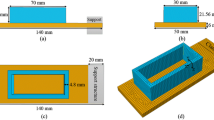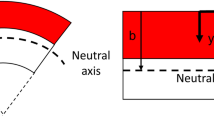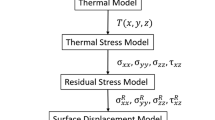Abstract
Undesired distortion often occurs in metal additive manufacturing due to the high temperature gradient resulting from repeated thermal cycles. A good understanding and fast predictions of in-situ distortion are essential to achieve high dimensional accuracy and prevent delamination or failure of build parts. Experimental investigations and numerical methods have been employed to study the in-situ distortion. However, the complex measurement systems and high computational cost limit their applications. An analytical modeling method with closed-form solutions is proposed in this paper to predict the in-situ distortion of laser cladding process without using iteration-based numerical calculations. The effects of build edges and geometry are considered, which include thermal convection and radiation at boundaries. Heat input and heat sink solutions modified from the point moving heat source model are added together to predict the temperature profile of the build and substrate. The die-substrate assembly model is used to calculate the deflection during the manufacturing process. Alloy 625 is selected to test the predictive accuracy and computational efficiency of the presented analytical model. The predicted results are close to the experimental data of in-situ distortion in literature. The computational time is less than 30 s. The good predictive accuracy and low computational cost make the presented method a promising approach to study the full-field temperature and distortion of a geometrically complex part.










Similar content being viewed by others
References
Levy, G. N., Schindel, R., & Kruth, J. P. (2003). Rapid manufacturing and rapid tooling with layer manufacturing (LM) technologies, state of the art and future perspectives. CIRP Annals, 52, 589–609. https://doi.org/10.1016/S0007-8506(07)60206-6
Yi, H., Qi, L., Luo, J., Zhang, D., & Li, N. (2019). Direct fabrication of metal tubes with high-quality inner surfaces via droplet deposition over soluble cores. Journal of Materials Processing Technology, 264, 145–154. https://doi.org/10.1016/j.jmatprotec.2018.09.004
Qi, L., Yi, H., Luo, J., Zhang, D., & Shen, H. (2020). Embedded printing trace planning for aluminum droplets depositing on dissolvable supports with varying section. Robotics and Computer-Integrated Manufacturing, 63, 101898. https://doi.org/10.1016/j.rcim.2019.101898
Luo, F., Yao, J. H., Hu, X. X., & Chai, G. Z. (2011). Effect of laser power on the cladding temperature field and the heat affected zone. Journal of Iron and Steel Research International, 18, 73–78. https://doi.org/10.1016/S1006-706X(11)60014-9
Szost, B. A., Terzi, S., Martina, F., Boisselier, D., Prytuliak, A., Pirling, T., Hofmann, M., & Jarvis, D. J. (2016). A comparative study of additive manufacturing techniques: Residual stress and microstructural analysis of CLAD and WAAM printed Ti–6Al–4V components. Materials & Design, 89, 559–567. https://doi.org/10.1016/j.matdes.2015.09.115
Ghasri-Khouzani, M., Peng, H., Rogge, R., Attardo, R., Ostiguy, P., Neidig, J., Billo, R., Hoelzle, D., & Shankar, M. R. (2017). Experimental measurement of residual stress and distortion in additively manufactured stainless steel components with various dimensions. Materials Science and Engineering: A, 707, 689–700. https://doi.org/10.1016/j.msea.2017.09.108
Heigel, J. C., Michaleris, P., & Palmer, T. A. (2015). In situ monitoring and characterization of distortion during laser cladding of Inconel® 625. Journal of Materials Processing Technology, 220, 135–145. https://doi.org/10.1016/j.jmatprotec.2014.12.029
Corbin, D. J., Nassar, A. R., Reutzel, E. W., Beese, A. M., & Michaleris, P. (2018). Effect of substrate thickness and preheating on the distortion of laser deposited Ti–6Al–4V. ASME. J. Manuf. Sci. Eng, 140(6), 061009. https://doi.org/10.1115/1.4038890
Denlinger, E. R., Heigel, J. C., MIchaleris, P., & Palmer, T. A. (2015). Effect of inter-layer dwell time on distortion and residual stress in additive manufacturing of titanium and nickel alloys. Journal of Materials Processing Technology, 215, 123–131. https://doi.org/10.1016/j.jmatprotec.2014.07.030
Biegler, M., Graf, B., & Rethmeier, M. (2018). In-situ distortions in LMD additive manufacturing walls can be measured with digital image correlation and predicted using numerical simulations. Additive Manufacturing, 20, 101–110. https://doi.org/10.1016/j.addma.2017.12.007
Xie, R., Chen, G., Zhao, Y., Zhang, S., Yan, W., Lin, X., & Shi, Q. (2019). In-situ observation and numerical simulation on the transient strain and distortion prediction during additive manufacturing. Journal of Manufacturing Processes, 38, 494–501. https://doi.org/10.1016/j.jmapro.2019.01.049
Dunbar, A. J., Denlinger, E. R., Gouge, M. F., Simpson, T. W., & Michaleris, P. (2017). Comparisons of laser powder bed fusion additive manufacturing builds through experimental in situ distortion and temperature measurements. Additive Manufacturing, 15, 57–65. https://doi.org/10.1016/j.addma.2017.03.003
Dunbar, A. J., Denlinger, E. R., Gouge, M. F., & Michaleris, P. (2016). Experimental validation of finite element modeling for laser powder bed fusion deformation. Additive Manufacturing, 12, 108–120. https://doi.org/10.1016/j.addma.2016.08.003
Afazov, S., Denmark, W. A. D., Toralles, B. L., Holloway, A., & Yaghi, A. (2017). Distortion prediction and compensation in selective laser melting. Additive Manufacturing, 17, 15–22. https://doi.org/10.1016/j.addma.2017.07.005
Biegler, M., Marko, A., Graf, B., & Rethmeier, M. (2018). Finite element analysis of in-situ distortion and bulging for an arbitrarily curved additive manufacturing directed energy deposition geometry. Additive Manufacturing, 24, 264–272. https://doi.org/10.1016/j.addma.2018.10.006
Mukherjee, T., Zhang, W., & DebRoy, T. (2017). An improved prediction of residual stresses and distortion in additive manufacturing. Computational Materials Science, 126, 360–372. https://doi.org/10.1016/j.commatsci.2016.10.003
Heigel, J. C., Michaleris, P., & Reutzel, E. W. (2015). Thermo-mechanical model development and validation of directed energy deposition additive manufacturing of Ti–6Al–4V. Additive manufacturing, 5, 9–19. https://doi.org/10.1016/j.addma.2014.10.003
Cheng, B., Shrestha, S., & Chou, K. (2016). Stress and deformation evaluations of scanning strategy effect in selective laser melting. Additive Manufacturing, 12, 240–251. https://doi.org/10.1016/j.addma.2016.05.007
Schoinochoritis, B., Chantzis, D., & Salonitis, K. (2017). Simulation of metallic powder bed additive manufacturing processes with the finite element method: A critical review. Proceedings of the Institution of Mechanical Engineers, Part B: Journal of Engineering Manufacture, 231, 96–117. https://doi.org/10.1177/0954405414567522
Ning, J., Sievers, D. E., Garmestani, H., & Liang, S. Y. (2019). Analytical modeling of in-process temperature in powder feed metal additive manufacturing considering heat transfer boundary condition. International Journal of Precision Engineering and Manufacturing-Green Technology. https://doi.org/10.1007/s40684-019-00164-8
Tang, M., Pistorius, P. C., & Beuth, J. L. (2017). Prediction of lack-of-fusion porosity for powder bed fusion. Additive Manufacturing, 14, 39–48. https://doi.org/10.1016/j.addma.2016.12.001
Wang, D., Liu, Y., Yang, Y., & Xiao, D. (2016). Theoretical and experimental study on surface roughness of 316L stainless steel metal parts obtained through selective laser melting. Rapid Prototyping Journal. https://doi.org/10.1108/RPJ-06-2015-0078
Ning, J., Wang, W., Zamorano, B., & Liang, S. Y. (2019). Analytical modeling of lack-of-fusion porosity in metal additive manufacturing. Applied Physics A, 125, 797. https://doi.org/10.1007/s00339-019-3092-9
Ji, X., Mirkoohi, E., Ning, J., & Liang, S. Y. (2020). Analytical modeling of post-printing grain size in metal additive manufacturing. Optics and Lasers in Engineering, 124, 105805. https://doi.org/10.1016/j.optlaseng.2019.105805
Fergani, O., Berto, F., Welo, T., et al. (2017). Analytical modelling of residual stress in additive manufacturing. Fatigue and Fracture of Engineering Materials and Structures, 40, 971–978. https://doi.org/10.1111/ffe.12560
de La Batut, B., Fergani, O., Brotan, V., et al. (2017). Analytical and numerical temperature prediction in direct metal deposition of Ti6Al4V. Journal of Manufacturing and Materials Processing, 1, 3. https://doi.org/10.3390/jmmp1010003
Ning, J., Sievers, D. E., Garmestani, H., & Liang, S. Y. (2020). Analytical modeling of in-situ deformation of part and substrate in laser cladding additive manufacturing of Inconel 625. Journal of Manufacturing Processes, 49, 135–140. https://doi.org/10.1016/j.jmapro.2019.11.013
Elsen, M. V., Baelmans, M., Mercelis, P., & Kruth, J. P. (2007). Solutions for modelling moving heat sources in a semi-infinite medium and applications to laser material processing. International Journal of Heat and Mass Transfer, 50, 4872–4882. https://doi.org/10.1016/j.ijheatmasstransfer.2007.02.044
Carslaw, H., & Jaeger, J. (1990). Conduction of heat in solids. Oxford: Oxford Science Publication.
Tsai, M. Y., Hsu, C. H., & Han, C. N. (2004). A note on Suhir’s solution of thermal stresses for a die-substrate assembly. ASME Journal of Electronic Packaging, 126, 115–119. https://doi.org/10.1115/1.1648056
INCONEL alloy 625. Spec. Met. Corp. http://www.specialmetals.com/assets/smc/do cuments/alloys/inconel/inconel-alloy625.pdf. (Retrieved Oct 2018).
Heigel, J. C., Gouge, M. F., Michaleris, P., & Palmer, T. A. (2016). Selection of powder or wire feedstock material for the laser cladding of Inconel® 625. Journal of Materials Processing Technology, 231, 357–365. https://doi.org/10.1016/j.jmatprotec.2016.01.004
Acknowledgements
The authors would like to acknowledge the financial support from The Boeing Company.
Author information
Authors and Affiliations
Corresponding authors
Ethics declarations
Conflict of interest
The authors declare that they have no conflict of interest.
Additional information
Publisher's Note
Springer Nature remains neutral with regard to jurisdictional claims in published maps and institutional affiliations.
Rights and permissions
About this article
Cite this article
Wang, W., Ning, J. & Liang, S.Y. In-Situ Distortion Prediction in Metal Additive Manufacturing Considering Boundary Conditions. Int. J. Precis. Eng. Manuf. 22, 909–917 (2021). https://doi.org/10.1007/s12541-021-00496-z
Received:
Revised:
Accepted:
Published:
Issue Date:
DOI: https://doi.org/10.1007/s12541-021-00496-z




